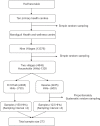Telemedicine Awareness and the Preferred Digital Healthcare Tools: A Community-based Cross-sectional Study from Rural Karnataka, India
- PMID: 38249713
- PMCID: PMC10795884
- DOI: 10.4103/ijcm.ijcm_770_22
Telemedicine Awareness and the Preferred Digital Healthcare Tools: A Community-based Cross-sectional Study from Rural Karnataka, India
Abstract
Background: The Indian government launched national teleconsultation services (eSanjeevani OPD) to provide safe doctor-to-patient consultations. This study aimed to determine the awareness and willingness to seek services from eSanjeevani OPDs.
Material and methods: This is a cross-sectional descriptive study conducted in Nandigudi village, Karnataka. The total sample size was 273, and participants were recruited using a systematic sampling technique.
Results: The prevalence of awareness about teleconsultations was 2.2% (n = 6, 95% CI: 0.8-4.7%). None of the participants utilized eSanjeevani services in the last year. Approximately 56.0% (n = 153, 95% CI: 49.9-62.0%) were willing to use eSanjeevani OPD. "Not being familiar" (n = 99, 82.5%) with eSanjeevani OPD was the major reason for unwillingness to use teleconsultation, and 73.8% (n = 113) preferred video calls as the mode of communication.
Conclusion: The majority of the participants were not aware of and were unwilling to use eSanjeevani OPD. Therefore, healthcare professionals should focus more on creating awareness of teleconsultations.
Keywords: COVID-19; Digital health; primary care.
Copyright: © 2023 Indian Journal of Community Medicine.
Conflict of interest statement
There are no conflicts of interest.
Figures
Similar articles
-
Evaluation of Free, Open-source, Web-based DICOM Viewers for the Indian National Telemedicine Service (eSanjeevani).J Digit Imaging. 2020 Dec;33(6):1499-1513. doi: 10.1007/s10278-020-00368-4. J Digit Imaging. 2020. PMID: 32661812 Free PMC article.
-
Exploring Quality Differences in Telemedicine Between Hospital Outpatient Departments and Community Clinics: Cross-sectional Study.JMIR Med Inform. 2022 Feb 15;10(2):e32373. doi: 10.2196/32373. JMIR Med Inform. 2022. PMID: 34978281 Free PMC article.
-
Assessment of knowledge and attitude of healthcare professionals regarding the use of telemedicine: A cross-sectional study from rural areas of Sindh, Pakistan.Front Public Health. 2022 Oct 26;10:967440. doi: 10.3389/fpubh.2022.967440. eCollection 2022. Front Public Health. 2022. PMID: 36388325 Free PMC article.
-
The effectiveness of teleconsultations in primary care: systematic review.Fam Pract. 2022 Jan 19;39(1):168-182. doi: 10.1093/fampra/cmab077. Fam Pract. 2022. PMID: 34278421 Free PMC article.
-
Reimagining India's National Telemedicine Service to improve access to care.Lancet Reg Health Southeast Asia. 2024 Sep 17;30:100480. doi: 10.1016/j.lansea.2024.100480. eCollection 2024 Nov. Lancet Reg Health Southeast Asia. 2024. PMID: 39323563 Free PMC article. Review.
Cited by
-
Perceptions and Experiences of Healthcare Providers and Patients Towards Digital Health Services in Primary Health Care: A Cross-Sectional Study.Cureus. 2024 Apr 23;16(4):e58876. doi: 10.7759/cureus.58876. eCollection 2024 Apr. Cureus. 2024. PMID: 38800186 Free PMC article.
References
-
- Ateriya N, Saraf A, Meshram VP, Setia P. Telemedicine and virtual consultation: The Indian perspective. Natl Med J India. 2018;31:215–8. - PubMed
LinkOut - more resources
Full Text Sources

